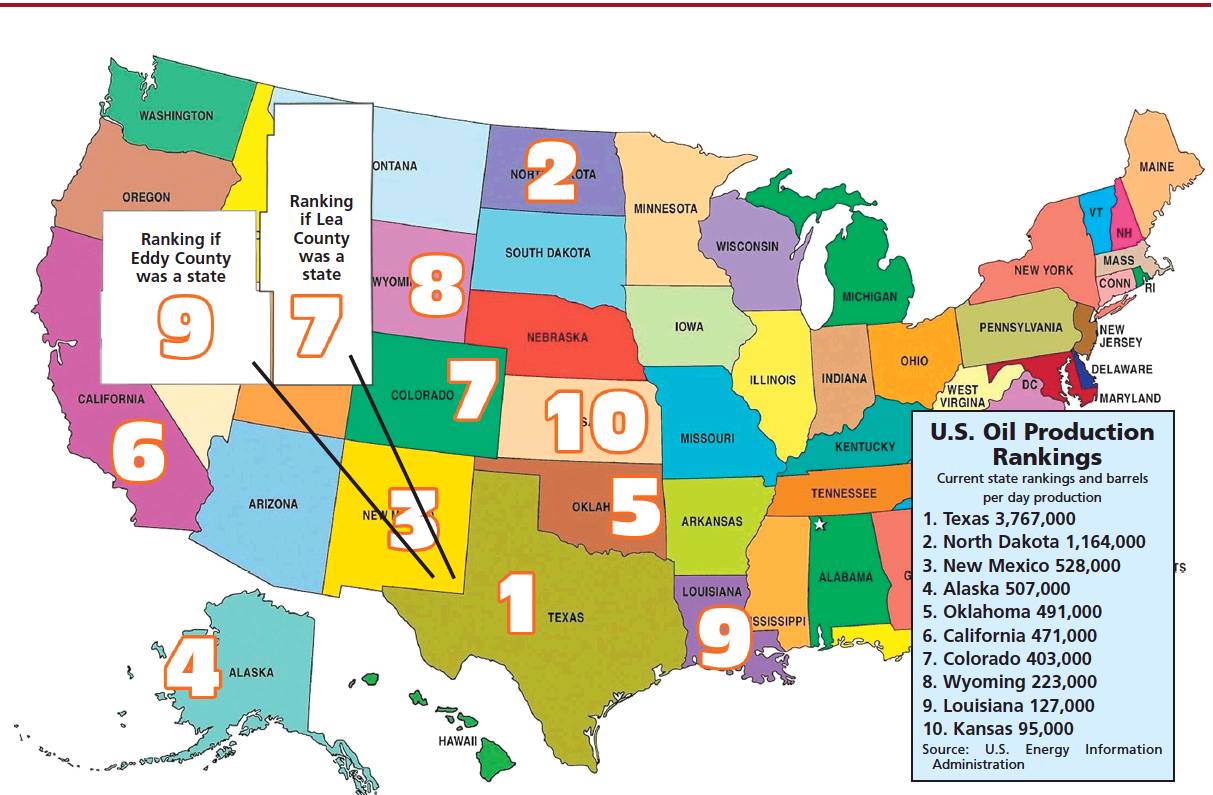Lea County shows muscle in oil production world
Local experts see boon at news of state’s top 3 ranking
CURTIS C. WYNNE NEWS-SUN
What if Lea County were it’s own state?
If that were the case, then Lea would be the seventh largest oil-producing state in the nation.
Steve Vierck, president and CEO of the Economic Development Corporation of Lea County, did the ranking from data released by the U.S. Energy Information Administration (EIA), an independent statistics and analysis agency within the U.S. Department of Energy.
Vierck said that October 2017 figures showed Lea County produced around 291,000 barrels of oil per day. For that measure, Lea’s neighbor to the west, Eddy County, produced 190,000 barrels of oil per day. Together, Vierck said the New Mexico’s two southeastern counties produce around 91 percent of the state’s crude oil.
These figures come after it was announced last week that New Mexico moved to No. 3 (around 528,000 barrels per day) in the state ranking of U.S. oil production, trailing only Texas (3.77 million) and North Dakota (1.16 million).
In the “what if” scenario, where Lea and Eddy were its own states, New Mexico would be eliminated from the top 3 ranking and Lea would be ranked seventh, behind No. 6 Colorado (403,000 barrels per day). Respectfully, Eddy would be ranked No. 9, behind No. 8 Wyoming (223,000).
“That’s pretty staggering when you look at it like that,” Vierck said on Saturday. “Lea County produces more than half the oil in the state.”
In the real world, New Mexico’s Top 3 ranking has local economy and oil business experts beaming when the news was announced last week.
EIA data also shows New Mexico hitting a record-high in monthly oil production — around 16,368,000 barrels in October — and is on pace to set an annual oil production record in 2017.
Data for November and December are not yet available, but the EIA shows steadily rising production each month since June, Vierck said.
Upon hearing of the state’s jump to third place, Rep. Steve Pearce, R-N.M., said, “New Mexico is a proven national leader in the responsible production and development of oil and gas.”
Pearce pointed out that revenues from oil and gas production help fund teachers, hospitals, law enforcement and other essential services local economies rely on.
“Not only does the production of oil and gas in New Mexico stimulate job growth for the state, but it also helps reduce our nation’s reliance on foreign energy resources,” he said. “New Mexico has the potential to increase its production by fixing the broken federal permitting processes that continuously forces jobs and production to move into Texas.”
A candidate for the state’s governorship, Pearce added, “I will continue to work to make this process more efficient to bring much needed jobs and revenue back to our state.”
The announcement comes at a good time, economically, according to Vierck.
“It’s good news fiscally because that means more jobs, more sales for local businesses and more tax revenues for the county,” he said.
County Finance Director Chip Low agreed, “Oil and gas production revenue is a major part of our general fund revenue. It’s dependent on the volume of oil produced in Lea County and the price. If it’s increasing, that’s a positive for the county budget.”
Low added that during the recent bust in oil prices, hitting a low in early 2016, the increased production helped soften the blow to the county budget. In October 2016, the EIA reported New Mexico producing 404,000 barrels per day, marking a 31 percent increase in production from 2016 to 2017.
“Now the price is going back up and production is up. That bodes well for us being able to continue to provide the services that we are currently providing,” he said. “We don’t have a lot of extra cash, but the increase in production is going to enable us to continue to provide the service and to advance in county infrastructure.”
Rep. Larry Scott, R-Hobbs, president and co-owner of Lynx Petroleum, breathed a little easier approaching this month’s upcoming budget-centered 30-day session of the New Mexico Legislature.
“The state budget situation is looking significantly brighter than it was just a few months ago,” he said. “There is projected to be some ‘new money’ available to the legislature and I will be advocating for conservative use of those funds possibly to effect some comprehensive tax reforms, which I think is still appropriate.”
Crediting technology advances in the industry, he added, “I predict if the prices stay anywhere in the vicinity of where they are now will yield sustained and growing production from the southeast (New Mexico area).” The price of WTI crude oil on Friday was about $62, significantly higher than the $25 seen in early 2016.”
During the opening of 2017, the price of WTI crude was around $10 less.
Vierck anticipates the increased production will bring in added gross receipts tax revenue to the cities, which depend of GRT funds for operating purposes, in the next few months.
He also hopes the increased production will encourage major oil and gas companies and midstream companies to establish regional offices and research facilities in Lea County.
The EIA is an independent statistics and analysis agency within the U.S. Department of Energy.
Curtis Wynne may be contacted at reporter3@hobbsnews. com.
